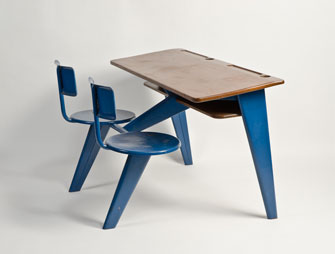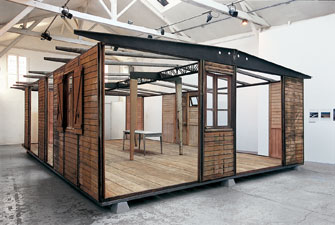Building for Better Days

Jean Prouvé (1901-1984) proved his talent as an innovative designer and builder over and over again during his long career, but he doesn’t seem to have received the respect and recognition he deserved from the French establishment during his lifetime, probably for two reasons: he was not a qualified architect, and his interest was in manufacturing for the masses rather than building gorgeous homes for the rich or trophy skyscrapers.
Prouvé is getting a sort of posthumous revenge today, however. His handsome but humble mass-manufactured school desks and chairs, and even architectural elements from buildings long ago torn down, are like gold on the design collector’s market today and are fetching higher and higher prices as original pieces become harder and harder to find.
That is not to say that Prouvé was unknown or ignored during his lifetime. This humanist designer who wanted to make handsome, lasting pieces that everyone could use had many commissions, was a respected teacher and chaired the jury that selected the architects for the Centre Georges Pompidou in Paris. (Click here to read the Design Museum’s excellent biography of him).
Today, his talent is finally being celebrated in Nancy, the northeastern French city where he built his career, which has just inaugurated a city-wide Prouvé festival (through October 28) with special exhibitions in four museums and a walk through the city to see remnants of his design legacy. Nancy owns half of Prouvé’s archives (the other half belongs to the Centre Pompidou in Paris) but has never before really put his work in the spotlight (interestingly, on the city’s French Wikipedia page, Prouvé is not even mentioned in the list of personalities associated with the city, although his father, the Ecole de Nancy painter Victor Prouvé, is).
This event offers visitors a great way to trace the progress of Prouvé’s life and career while also discovering many other spectacular sites in this city with a long history as the capital of Lorraine, a stunning ensemble of 18th-century architecture and a rich Art Nouveau heritage.
A good place to begin the Prouvé tour is in a treasure house of Art Nouveau, the Musée de l’Ecole de Nancy, with its beautiful garden and amazing collection of Art Nouveau rooms, furnishings and artworks. Here the focus of a small exhibition entitled “Jean Prouvé, Ferronnier d’Art” is on the very beginning of Prouvé’s career, when he was an artist-blacksmith. On display are some of his wrought-iron pieces from 1917-25. While they show the influence of his father’s work (some of which is on show), they also clearly demonstrate his flair for design in gates, banisters, radiator covers and more.
From there Prouvé went on to become a great innovator in the use of metals. As soon as new materials like steel and aluminum and new techniques became available, he experimented with ways of incorporating them into furniture-making in his Atelier Jean Prouvé, founded in 1931.
This long period of inventive productivity is extremely well-documented in the show “Jean Prouvé, Constructeur” at the Musée de l’Histoire du Fer (Museum of the History of Iron; iron was one of the area’s natural resources, exploited until recently), where excellent interactive screen displays coupled with models of Prouvé’s work explain clearly the technical aspects of his building innovations. Developed by teachers, the visual explanations for children are also great for technically challenged adults like me. They helped me understand right away techniques that I had struggled to understand from written explanations. This permanent exhibition is on show in a handsome museum with a steel structure built by Prouvé’s son, architect Claude, and the architects Jacques and Michel André, in collaboration with Jean Prouvé.
An exhibition at the Musée Historique Lorrain, “Jean Prouvé à Nancy, Construire des Jours Meilleurs,” focuses on Prouvé’s ongoing interest in building prefabricated homes for

people made homeless by war, natural disasters and poverty, and on the wooden furniture he made during World War II when metal was not available. (A member of the Resistance during World War II, Prouvé was named mayor of Nancy in 1944, but left after eight months to devote himself to his profession.)
At the Musée des Beaux-Arts de Nancy, in a building with an architecturally interesting mix of old (18th century) and new (1999), one of Prouvé’s prefab houses, La Maison Tropicale, has been set up in the garden, while detailed documentation on its design can be found inside. A permanent exhibition, “Jean Prouvé, un Artiste aux Talents Multiples,” puts Prouvé’s furniture designs in the context of the art of the period, with works by the likes of Frank Stella and the French artist François Morellet.
Prouvé’s work is put into a design context in an exhibition at the Galeries Poirel, “L’Emotion Design, la Collection d’Alexander von Vegesack,” an extensive overview of the collection of von Vegesack, founder and Director of the Vitra Design Museum.
One must-stop for any visitor interested in Prouvé is the isolated hilltop house he built not long after one of the most traumatic experiences of his life, the loss in 1953 of his factory in Maxéville, where he had put his advanced technical and social ideas (e.g., worker participation and supplemental benefits) into practice. The house, which is inhabited and can only be visited during a guided tour or by appointment, summed up many of the architectural principles he had developed and made use of elements salvaged from the factory.
The organizers have put together an excellent Web site for the event (with an English version!), with details on all the exhibitions, a map of the Route Jean Prouvé and information on visiting Jean Prouvé’s house and workshop. The event continues until October 28.
In Paris, the Galerie Patrick Seguin (5, rue des Taillandiers, 75011; tel.: 01 47 00 32 35) has set up a prototype of one of Prouvé’s prefab houses, the Maison des Jours Meilleurs (Home for Better Days), designed in response to Abbé Pierre’s call for emergency housing for the homeless. This house, which was set up in seven hours on the Quai Alexandre III in Paris in 1956, looks almost luxurious to us today. It was never approved by for use by the authorities. This show continues until September 29.
Favorite